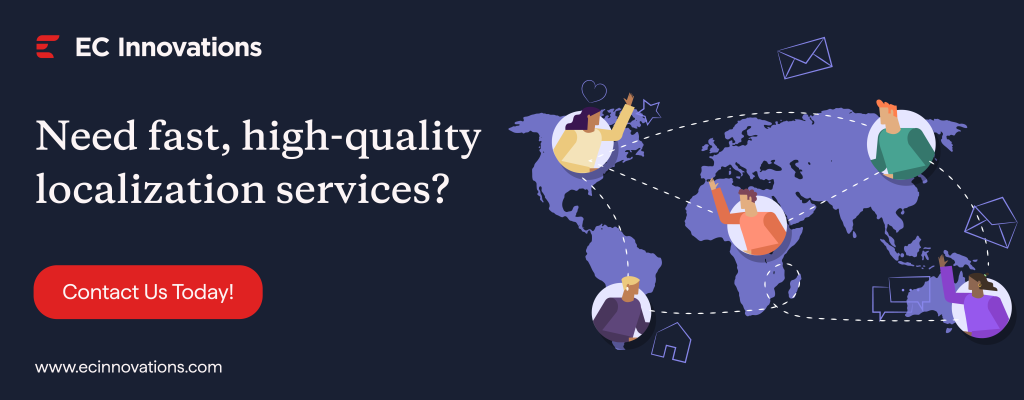Localization is something you experience every time you use a global app to order food and see the prices in your currency. You can easily play a video game where characters speak your language. Shopping on websites that accept your preferred payment method happens because companies have invested in localization.
For global success, many business owners don’t realize how important it is to market themselves locally. 40% of people who shop online won’t buy anything if the content isn’t available in their language, according to CSA’s ”Can’t Read Won’t Buy” study. Even more interesting, 76% of people would rather buy something if the information about it is in their language, and 60% rarely buy from websites that only speak English.
Localization is more than just a nice thing to have for businesses that want to grow internationally. It’s a must for businesses and has a direct effect on sales, customer trust, and market share around the world.
What is Localization?
The practice of modifying your goods, services, and information to suit the unique requirements of different markets is known as localization. There is a big distinction between translation, localization, and transcreation, even though many people mistake localization with translation. While localization changes your entire customer experience to make it feel natural to local users, translation only changes words from one language to another.
Effective localization includes several important elements that go far beyond basic language conversion:
- Cultural References and Communication Styles: While marketing humor may be effective in the United States, it may fall flat in Japan. Localization adapts idioms, cultural references, and communication approaches to match what local audiences expect and appreciate.
- Local Currencies and Format Preferences: Confusion is eliminated by displaying prices in local currencies, for instance, euros for European customers instead of dollars. Additionally, regional formatting conventions are essential: in Europe, dates are written as DD/MM/YYYY rather than MM/DD/YYYY, and numbers use a period or space as a thousands separator and a comma for decimals, for example, 1.000,50 instead of the US format 1,000.50.
- Legal and Regulatory Compliance: Every market has unique legal requirements that businesses must follow to operate successfully. European users expect GDPR compliance, California residents need specific privacy disclosures, and medical devices require localized documentation to meet safety standards.
- Visual Elements and Brand Adaptation: Colors carry different meanings across cultures, so what works in one region might backfire in another. White symbolizes purity in Western cultures but can represent mourning in some Asian cultures, making visual localization crucial.
- Customer Service Expectations: Response time expectations, communication formality levels, and preferred service channels vary significantly between different markets and cultural groups.
The localization process also includes technical considerations like supporting right-to-left languages, accommodating text expansion, and ensuring your platform works properly with local browsers and devices.
Why Localization is Critical for Global Business Success
Smart localization builds trust and delivers real business results. When people browse your website in their language and pay with familiar methods, they spend more time and buy more. This comfort directly increases sales and order values.
Localized companies don’t just find new customers – they find loyal ones. When you adapt to local preferences, people see you as part of their community, not another foreign business. Customers who feel understood become long-term fans.
Good localization beats competitors who use generic, one-size-fits-all content. Your localized approach shows you care about their market, giving you a valuable edge.
Smart companies invest in proper localization upfront to avoid expensive mistakes. Poor translations damage reputation, cultural misunderstandings create customer service problems, and compliance issues cost more than doing things right initially. Companies that invest in full localization typically see much higher revenue growth.
When Do You Need Localization?
Localization services become essential in several key business scenarios that most growing companies eventually face. These situations include the following:
- International Market Expansion: Before you go into a new market, localization helps you learn about and meet the needs of that market. It doesn’t matter if you’re a software company going into Europe or an online store going into Southeast Asia.
- Digital Product Development: Your development approach should include localization if you’re creating software, mobile apps, or websites for audiences. It is usually pricier to retrofit localization after launch than to provide foreign support from the start.
- Global Marketing Campaigns: Each target audience in their local environment needs to emotionally connect with your marketing communications. This entails modifying offers, language, images, and channel techniques to conform to cultural norms and geographical preferences.
- Regulatory Compliance Requirements: Strict local laws that differ from nation to nation frequently apply to sectors including healthcare, finance, and food services. To prevent legal issues, localization makes sure your labeling, documentation, and procedures adhere to local norms.
- Customer Experience Optimization: Localization has the potential to significantly boost your performance in current markets, even if you are already conducting business abroad. Numerous businesses uncover issues that they were unaware were influencing the satisfaction of their global audience.
Different industries have their own localization problems that need different solutions. For example, game firms need to change their stories and characters to be more culturally sensitive. Financial services need to follow local banking rules and payment systems, and healthcare organizations need to make sure their medical translations are accurate and fulfill local approval criteria. To be successful in global marketplaces, you need to learn a lot about the special needs of your sector.
Examples of Localization
Real-world success stories demonstrate how effective localization creates competitive advantages across different industries:
McDonald
McDonald’s does more than just change the names of its menu items for foreign countries. They completely changed their cuisine to fit the preferences and dietary needs of people in different areas. The McAloo Tikki burger, which has spicy potatoes atop it, is offered in India, where many of the customers are vegetarians.

Netflix
Netflix does more than merely translate subtitles; it also spends a lot of money on making material in other languages and adapting it to different cultures. Their original shows, like “Sacred Games” in India and “Money Heist” in Spain, use local storytelling styles. These programs are popular in their local markets and often become international hits.

Spotify
The localization of Spotify goes much beyond simply translating its user interface into other languages. The platform creates playlists tailored to a particular area, collaborate with local musicians, and modify their music recommendation algorithms to suit local listening preferences. Spotify was able to successfully compete against well-known local music services in a number of countries because of this all-encompassing strategy.

Airbnb
By adapting payment mechanisms and trust signals that are significant to various ethnic groups, Airbnb has achieved success on a global scale. The company has modified its review systems to support local trust-building preferences. Local payment systems like Alipay in China have been integrated into the platform. Hosts can also create property listings in different languages.

These examples show that careful localization can give multinational businesses a real local feel, which can give them an edge over their competitors for a long time.
Common Challenges in Localization and How to Overcome Them
Companies expanding to new countries face big problems that can ruin their plans. Poor translations or cultural mistakes quickly damage brand reputation. The solution: work with native speakers, create thorough review processes, and conduct extensive testing of localized content with real users before launch.
Companies must maintain brand integrity while appealing to local tastes. They struggle to decide which brand aspects stay consistent and which can change. Clear brand standards help teams make consistent decisions.
Building technology for different countries is challenging. Apps and websites need multiple languages, currencies, and regional compliance. Early planning makes the task easier. Choose tools that support internationalization to save time and money later.
Localization requires long-term investment, not one-time costs. Smart businesses target promising markets first, then expand gradually based on returns. Pay attention to cultural differences – what works in one culture may offend another.
The Localization Process
Effective localization follows a structured approach that ensures quality results and maximizes your investment:
- Market Research and Analysis: To make wise localization decisions, you need to know what language your target market speaks, what their cultural values are, what the competition is like, and what the rules are.
- Content Assessment and Prioritization: When you enter new markets, not all of your content needs to be localized right away. Find out which content, features, and customer touchpoints have the biggest effect on user experience and making money.
- Professional Translation and Cultural Adaptation: Skilled translators who know your industry work to adapt your content while keeping your brand’s unique voice. They make sure your message feels natural and appropriate in each culture while still delivering the same meaning and emotional impact you intended.
- Technical Implementation and Integration: Your development team adds localized content and changes layouts to account for text expansion. They make sure all features work properly and everything functions as it should. This means testing in diverse languages and regions with different local technological needs.
- Quality Assurance and User Testing: Strict testing finds translation mistakes, cultural challenges, and technical problems before they get to your clients. This full procedure includes testing the language, the functionality, and the culture with real consumers in the area.
- Launch and Continuous Optimization: Following the launch of your localized experience, closely monitor user feedback and continuously analyze performance data. Use this information to keep your translated content better and better based on how real users act.
Conclusion
In today’s connected global marketplace, customers expect experiences that feel specifically designed for their local needs and preferences. Localization makes this level of personalization possible by transforming your global offerings into locally relevant solutions that build trust and drive sustainable growth.
By investing in full localization, businesses show that they are trustworthy local players who really understand the cultural backgrounds of their clients. As competition around the world gets tougher and customer expectations keep going up, this strategic advantage becomes more and more valuable. Contact our team today to discuss how professional localization may expedite your worldwide expansion and help you build enduring partnerships in new markets.




